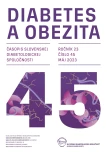Ceramides and cardiovascular disease
Authors:
Ján Murín
Authors‘ workplace:
I. interná klinika LF UK a UNB, Nemocnica Staré Mesto, Bratislava
Published in:
Diab Obez 2023; 23(45): 29-33
Category:
Reviews
Overview
Obesity is associated with an increased cardiovascular risk and therefore the knowledge of a potential role of dysregulations in the adipose tissues (AT) seems to be important. A study looking at metabolites (ceramides, sfingomyelins, free fatty acids, other) secreted by intrathoracic and subcutaneous AT in obese patients with atherosclerosis was conducted, and some of these patients were undergoing coronary bypass surgery. The underlying mechanisms were explored in human endothelial cells and their clinical value was tested against hard clinical endpoints. The intrathoracic AT volume is associated significantly with arterial oxidative stress and there are significant differences in sphingolipid secretion between intrathoracic AT and subcutaneous AT. C16:0-ceramide and its derivatives are the most abundant species released within adipocyte-derived extracellular vesicles. High intrathoracic AT sphingolipid secretion was significantly associated with reduced endothelial NO bioavailability and increased superoxide generated in human vessels. Circulating C16:0-ceramide correlated positively with intrathoracic AT production of ceramides, dysregulated vascular redox signaling and increased systemic inflammation in patients with atherosclerosis. High plasma C16:0-ceramide is independently related with increased risk for cardiac mortality. In a randomized controlled clinical trial, 1-year treatment of obese patients with the GLP-1 RA (liraglutid) supressed plasma C16:0-ceramide and C16:0-glycosylceramide. These results demonstrate for the 1st time in humans that AT-derived ceramides are modifiable regulators of vascular redox state in obesity and with an impact on cardiac mortality in advanced atherosclerosis.
Keywords:
vascular inflammation – Atherosclerosis – cardiovascular disease – adipose tissues – ceramides – intrathoracic adipose tissue– liraglutide
Sources
1. Akawi N, Checa A, Antonopoulos AS et al. Fat-secreted ceramides regulate vascular redox state and influence outcomes in patients with cardiovascular disease. J Am Coll Cardiol 2021; 77(20): 2494–2513. Dostupné z DOI: <http://dx.doi.org/10.1016/j.jacc.2021.03.314>.
2. Akoumianakis I, Sanna F, Margaritis M et al. Adipose tissue-derived WNT5A regulates vascular redox signaling in obesity via USP17/RACI-mediated activation of NADPH oxidases. Sci Transl Med 2019; 11(510): eaav5005. Dostupné z DOI: <http://dx.doi.org/10.1126/scitranslmed.aav5055>.
3. Margaritis N, Antonopoulos AS, Digby J et al. Interactions between vascular wall and perivascular adipose tissue reveal novel roles for adiponectin in the regulation of endothelial nitric oxide synthase function in human vessels. Circulation 2013; 127(22): 2209–2221. Dostupné z DOI: <http://dx.doi.org/10.1161/CIRCULATIONAHA.112.001133>.
4. Xia JY, Holland WL, Kusminski CM et al. Targeted induction of ceramide degradation leads to improved systemic metabolism and reduced hepatic steatosis. Cell Metab 2015; 22(2): 266–278. Dostupné z DOI: <http://dx.doi.org/10.1016/j.cmet.2015.06.007>.
5. Yamaguchi M, Miyashita Y, Kumagai Y et al. Change in liver and plasma ceramides during D-galactosamine-induced acute hepatic injury by LCMS/MS. Bioorg Med Chem Lett 2004; 14(15): 4061–4064. Dostupné z DOI: <http://dx.doi.org/10.1016/j.bmcl.2004.05.046>.
6. Havulinna AS, Sysi-Aho M, Hilvo M et al. Circulating ceramides predict cardiovascular outcomes in the population-based FINRISK 2002 cohort. Arterioscler Thromb Vasc Biol 2016; 36(12): 2424–2430. Dostupné z DOI: <http://dx.dpo.org/10.1161/ATVBAHA.116.307497>.
7. Laaksonen R, Ekroos K, Sysi-Aho M, et al. Plasma ceramides predict cardiovascular death in patients with stable coronary artery disease and acute coronary syndromes beyond LDL-cholesterol. Eur Heart J 2016; 37(25):1967–1976. Dostupné z DOI: <http://dx.doi.prg/10.1093/eurheartj/ehw148>.
8. Javaheri A, Allegood JC, Cowart LA et al. Circulating ceramide 16:0 in heart failure with preserved ejection fraction. J Am Coll Cardiol 2020; 75(17): 2273–2275. Dostupné z DOI: <http://dx.doi.org/10.1016/j.jacc.2020.02.062>.
9. Lemaitre RN, Jensen PN, Hoofnagle A et al. Plasma ceramides and sphingomyelins in relation to heart failure risk. Circ Heart Fail 2019; 12(17): e005708. Dostupné z DOI: <http://dx.doi.org/10.1161/CIRCHEARTFAILURE.118.005708>.
10. Wang DD, Toledo E, Hruby et al. Plasma ceramides, Mediterranean diet and incident cardiovascular disease in the PREDIMED trial (Prevencion con Dieta Mediterranea). Circulation 2017; 135(21): 2028–2040. Dostupné z DOI: <http://dx.doi.org/10.1161/CIRCULATIONAHA.116.024261>.
11. Forstermann U, Xia N, Li H. Roles of vascular oxidative stress and nitric oxide in the pathogenesis of atherosclerosis. Circ Res 2017; 120(4): 713–735. Dostupné z DOI: <http://dx.doi.org/10.1161/CIRCRESAHA.116.309326>.
12. Antoniades C, Shirodaria C, Crabtree M et al. Altered plasma versus vascular biopterins in human atherosclerosis reveal relationships between endothelial nitric oxide synthase coupling, endothelial function, and inflammation. Circulation 2007; 116(24): 2851–2859. Dostupné z DOI: <http://dx.doi.org/10.1161/CIRCULATIONAHA.107.704155>.
13. Cavus E, Karakas M, Ojeda FM et al. Association of circulating metabolites with risk of coronary heart disease in a European population: results from the Biomarkers for Cardiovascular risk Assessment in Europe (BiomarCARE) Consortium. JAMA Cardiol 2019; 4(12): 1270–1279. Dostupné z DOI: <http://dx.doi.org/10.1001/jamacardio.2019.4130>.
14. Bruce CR, Risis S, Babb JR et al. Overexpression of sphingosine kinase 1 prevents ceramide accumulation and ameliorates muscle insulin resistance in high-fat diet-fed mice. Diabetes 2012; 61(12): 3148–3155. Dostupné z DOI: <http://dx.doi.org/10.2337/db12–0029>.
15. Schiffmann S, Hartmann D, Fuchs S et al. Inhibitors of specific ceramide synthases. Biochimie 2012; 94(2): 558–565. Dostupné z DOI: <http://dx.doi.org/10.1016/j.biochi.2011.09.007>.
16. Mirani M, Favacchio G, Serone E et al. Liraglutide and cardiovascular outcomes in a real world type 2 diabetes cohort. Pharmacol Res 2018; 137: 270–279. Dostupné z DOI: <http://dx.doi.org/10.1016/j.phrs.2018.09.003>.
Labels
Diabetology ObesitologyArticle was published in
Diabetes and obesity

2023 Issue 45
Most read in this issue
- The dual GIP and GLP1 receptor agonist tirzepatide: a new effective treatment for type 2 diabetes mellitus
- Practical experience with dapagliflozin: case reports
- Evaluation of the current situation and possibilities in the management of obesity in Slovakia
- Diabetes mellitus and options for early prevention of heart failure
